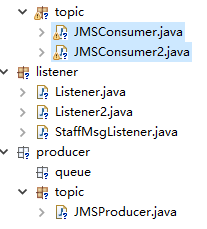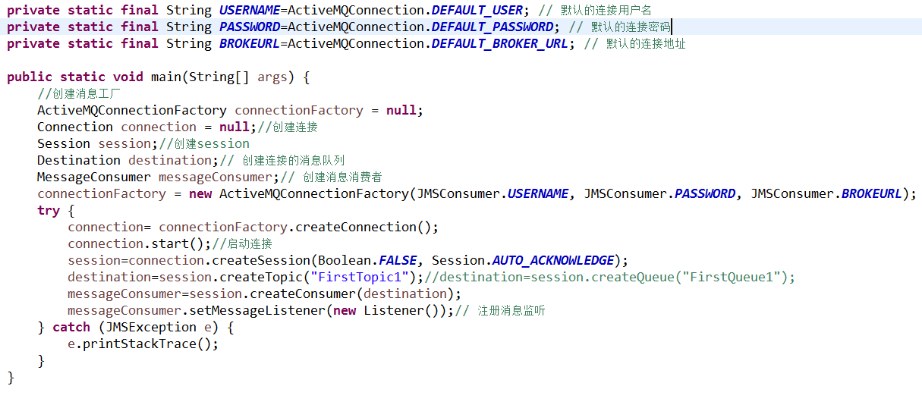开发环境
我们使用的是ActiveMQ 5.11.1 Release的Windows版,官网最新版是ActiveMQ 5.12.0 Release,大家可以自行下载,下载地址。
需要注意的是,开发时候,要将apache-activemq-5.11.1-bin.zip解压缩后里面的activemq-all-5.11.1.jar包加入到classpath下面,这个包包含了所有jms接口api的实现。
搭建开发环境
建立项目,我们只需要建立一个java项目就可以了,导入jar包,项目截图:

1、编写生产者
package com.activemq.producer.topic; import javax.jms.Connection; import javax.jms.Destination; import javax.jms.JMSException; import javax.jms.MessageProducer; import javax.jms.Session; import javax.jms.TextMessage; import org.apache.activemq.ActiveMQConnection; import org.apache.activemq.ActiveMQConnectionFactory; public class JMSProducer { private static final String USERNAME=ActiveMQConnection.DEFAULT_USER; // 默认的连接用户名 private static final String PASSWORD=ActiveMQConnection.DEFAULT_PASSWORD; // 默认的连接密码 private static final String BROKEURL=ActiveMQConnection.DEFAULT_BROKER_URL; // 默认的连接地址 private static final int SENDNUM=10; // 发送的消息数量 public static void main(String[] args) { ActiveMQConnectionFactory connectionFactory; // 连接工厂 Connection connection = null; // 连接 Session session; // 会话 接受或者发送消息的线程 Destination destination; // 消息的目的地 MessageProducer messageProducer; // 消息生产者 // 实例化连接工厂 connectionFactory=new ActiveMQConnectionFactory(JMSProducer.USERNAME, JMSProducer.PASSWORD, JMSProducer.BROKEURL); try { connection=connectionFactory.createConnection(); // 通过连接工厂获取连接 connection.start(); // 启动连接 session=connection.createSession(Boolean.TRUE, Session.AUTO_ACKNOWLEDGE); // 创建Session destination=session.createTopic("FirstTopic1"); // 创建消息队列 messageProducer=session.createProducer(destination); // 创建消息生产者 sendMessage(session, messageProducer); // 发送消息 session.commit(); } catch (Exception e) { // TODO Auto-generated catch block e.printStackTrace(); } finally{ if(connection!=null){ try { connection.close(); } catch (JMSException e) { // TODO Auto-generated catch block e.printStackTrace(); } } } } /** * 发送消息 * @param session * @param messageProducer * @throws Exception */ public static void sendMessage(Session session,MessageProducer messageProducer)throws Exception{ for(int i=0;i<JMSProducer.SENDNUM;i++){ TextMessage message=session.createTextMessage("ActiveMQ 发送的消息"+i); System.out.println("发送消息:"+"ActiveMQ 发送的消息"+i); messageProducer.send(message); } } }
2、编写监听器
为了模拟两个客户端接收消息,我们写两个监听器
public class Listener implements MessageListener { @Override public void onMessage(Message message) { // TODO Auto-generated method stub try { System.out.println("订阅者一收到的消息:"+((TextMessage)message).getText()); } catch (JMSException e) { // TODO Auto-generated catch block e.printStackTrace(); } } }
public class Listener2 implements MessageListener { @Override public void onMessage(Message message) { // TODO Auto-generated method stub try { System.out.println("订阅者二收到的消息:"+((TextMessage)message).getText()); } catch (JMSException e) { // TODO Auto-generated catch block e.printStackTrace(); } } }
3、编写消费者
connectionFactory = new ActiveMQConnectionFactory(JMSConsumer.USERNAME, JMSConsumer.PASSWORD, JMSConsumer.BROKEURL);
用户名和密码这两个参数可以不写

package com.activemq.consumer.topic; import javax.jms.Connection; import javax.jms.Destination; import javax.jms.JMSException; import javax.jms.MessageConsumer; import javax.jms.Session; import org.apache.activemq.ActiveMQConnection; import org.apache.activemq.ActiveMQConnectionFactory; import com.activemq.listener.Listener; public class JMSConsumer { private static final String USERNAME=ActiveMQConnection.DEFAULT_USER; // 默认的连接用户名 private static final String PASSWORD=ActiveMQConnection.DEFAULT_PASSWORD; // 默认的连接密码 private static final String BROKEURL=ActiveMQConnection.DEFAULT_BROKER_URL; // 默认的连接地址 public static void main(String[] args) { //创建消息工厂 ActiveMQConnectionFactory factory = new ActiveMQConnectionFactory(JMSConsumer.BROKEURL); Connection connection = null; Session session; Destination destination; MessageConsumer messageConsumer; try { //创建连接 connection= factory.createConnection(); //启动连接 connection.start(); //创建session session=connection.createSession(Boolean.FALSE, Session.AUTO_ACKNOWLEDGE); // 创建连接的消息队列 destination=session.createTopic("FirstTopic1"); // 创建消息消费者 messageConsumer=session.createConsumer(destination); // 注册消息监听 messageConsumer.setMessageListener(new Listener()); } catch (JMSException e) { // TODO Auto-generated catch block e.printStackTrace(); } } }
package com.activemq.consumer.topic; import javax.jms.Connection; import javax.jms.Destination; import javax.jms.JMSException; import javax.jms.MessageConsumer; import javax.jms.Session; import org.apache.activemq.ActiveMQConnection; import org.apache.activemq.ActiveMQConnectionFactory; import com.activemq.listener.Listener2; public class JMSConsumer2 { private static final String USERNAME=ActiveMQConnection.DEFAULT_USER; // 默认的连接用户名 private static final String PASSWORD=ActiveMQConnection.DEFAULT_PASSWORD; // 默认的连接密码 private static final String BROKEURL=ActiveMQConnection.DEFAULT_BROKER_URL; // 默认的连接地址 public static void main(String[] args) { //创建消息工厂 ActiveMQConnectionFactory factory = new ActiveMQConnectionFactory(JMSConsumer2.BROKEURL); Connection connection = null; Session session; Destination destination; MessageConsumer messageConsumer; try { //创建连接 connection= factory.createConnection(); //启动连接 connection.start(); //创建session session=connection.createSession(Boolean.FALSE, Session.AUTO_ACKNOWLEDGE); // 创建连接的消息队列 destination=session.createTopic("FirstTopic1"); // 创建消息消费者 messageConsumer=session.createConsumer(destination); // 注册消息监听 messageConsumer.setMessageListener(new Listener2()); } catch (JMSException e) { // TODO Auto-generated catch block e.printStackTrace(); } } }
4、启动消费者和生产者
先启动消费者,再启动生产者,顺序不可颠倒。
